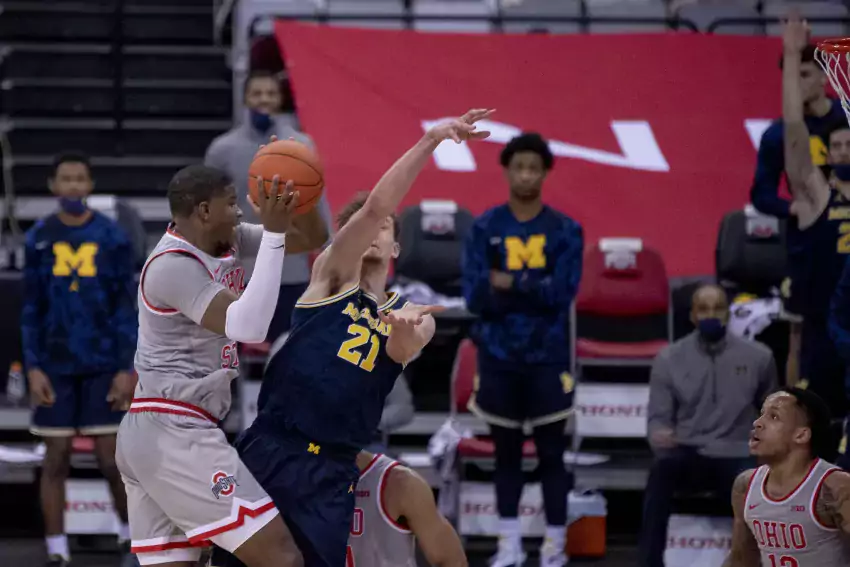
Big Ten Reset Hands Out Awards, Part Two

Previously: The Usual Categories, The Official Big Ten Awards Roundtable
Alright, let's get weird.
Regular Season Awards: The Unusual Categories
BEST SURPRISE: EJ LIDDELL, OHIO STATE
For the player who's most exceeded preseason expectations, which isn't quite the same thing as most improved player.
Not much has changed since I gave this same award to him midway through the conference season:
We barely mentioned Liddell in our season preview roundtable, and while I had a chance to look smart when I finally brought him up, I blew it by only bringing him up in the context of being undersized for his position. The 6'7" post player has improved in nearly every meaningful statistical category despite getting most of his minutes at center instead of his more natural fit at power forward. ...
Instead of Liddell being a reason OSU is held back, he's the best player on what's once again one of the country's more surprisingly successful teams. He can function as the only interior presence in a five-out attack or play next to Kyle Young, who's often planted in the dunker spot waiting for dumpoffs and offensive rebounds.
A true three-level scorer, Liddell opened up OSU's top-five offense with his ability to score at all three levels, especially with fellow big Kyle Young adding the corner three-pointer to his arsenal. While both are undersized, they still did big man stuff—other than protect the rim—at a high level, giving Chris Holtmann the unusual luxury of playing two bigs in a five-out system.
Liddell scored well into the double figures most every game because his versatile offensive game gave him a route to attack pretty much any defender. He could bully smaller players or drag slower-footed centers into the deep water with both his spot-up shooting and his face-up game:
Liddell found a way to either mitigate his weaknesses or turn them into strengths. I'd love to see him next to more of a traditional center who still can stretch the floor, though I realize those aren't exactly easy to find, so OSU could construct a title-caliber defense. (In theory. In practice, OSU being bad at defense is actually good, in my opinion.) Instead, they merely built a championship-level offense around a 6'7, 240-pound big man.
Other contenders: Donta Scott, Jacob Young, Hunter Dickinson
[Hit THE JUMP for worst surprise, most extreme JAS™, the JJJ award, disaster factory, and more.]
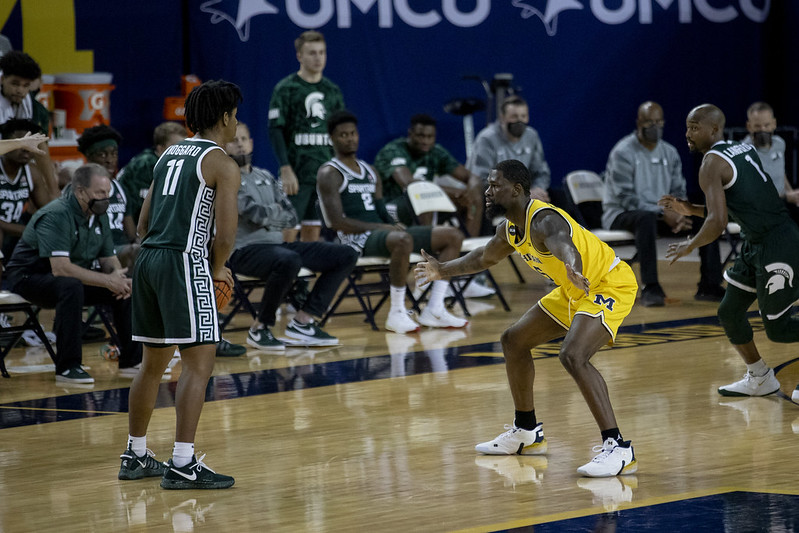
Watts (2, on bench) had a hard time keeping Tom Izzo's trust [Campredon]
WORST SURPRISE: ROCKET WATTS, MICHIGAN STATE
The last category, but bad.
Certain regular season finales be damned, this was an incredibly disappointing year for both Michigan State and their expected breakout star, sophomore guard Rocket Watts. While Watts produced inconsistent results replacing the great Cassius Winston at point guard in non-conference play, he seemed to finding a good balance between scorer and distributor, netting 20+ points in wins over Duke and Detroit and dishing out six assists in victories against Notre Dame, Western Michigan, and Oakland.
This is how Big Ten play went (via Bart Torvik):

sorted by worst O-Rating, all B1G players, minimum 40% minutes
In the first three conference games, Watts shot a combined 5-for-29 from the field, which prompted Tom Izzo to bench him in favor of three-star freshman AJ Hoggard—who finished B1G season with a 74.7 O-Rating but didn't make the above list because he missed the minutes cutoff by five percentage points.
Watts wouldn't again score 20 points—or so much as surpass 13—until (sigh) the final game of the regular season. He surpassed two assists only three times after Christmas; in one of those he had five turnovers and the opponent was Nebraska. He started only six of the last 17 games and only regained some of his playing time because of Foster Loyer's season-ending injury. Jack Hoiberg made occasional cameos during competitive portions of games.
Some offensive struggles weren't unanticipated, even if nobody suspected they'd be this bad. Watts' defense may have been even more disappointing. After grading out in the 54th percentile as the primary defender as a freshman while showing a great deal of athletic potential, Watts regressed in 2020-21, dropping to the 20th percentile while getting picked on more frequently, per Synergy. Izzo ended up playing the freshman Hoggard over Watts for much of the season because he could trust the former more on defense. Watts finished with the worst defensive box plus-minus in the Big Ten by a healthy distance.
Did Izzo also play a role in this award by toying around with Watts' playing time around position all season even though he was clearly the most talented player in the backcourt? Perhaps. There's still a lot of evident talent, it just rarely came together for him.
Other contenders: Nate Reuvers, Joey Hauser
PLEASE HELP THIS MAN: TRAYCE JACKSON-DAVIS, INDIANA
For the best player getting the least amount of help from his teammates.
Remember when Brian posted about how focusing on two-point percentage is a good way to cut through the noise of Hoop Lens on/off numbers? Check these out:

cupcakes removed
Sheesh. When TJD was on the floor, Indiana was plus one percentage point on twos against their opposition. When he was off the floor, they were MINUS TEN POINT SIX. The offense also took care of the ball better and drew more fouls with TJD while preventing more three-point attempts on defense; the team's points per possession allowed with TJD off the floor is artificially deflated by extreme three-point and free throw luck.
Jackson-Davis averaged 8.5 more points, 4.1 more free throw attempts, and 1.6 more rebounds than IU's second-leading player in each respective category. He also led the team in blocks and minutes played, the latter a rarity for a center. While his better games didn't always lead to team success because the play around him was so inconsistent, a poor game from him all but doomed the Hoosiers—they went 2-7 in the nine games he posted an O-Rating lower than 100 with wins against #72 Providence and #68 Northwestern (the latter in overtime).
He's stuck in a terrible offensive environment, usually playing with another paint-bound big man and at least one perimeter player who can't shoot. He had to defend the gauntlet of Big Ten centers and be the team's primary rim protector without getting into foul trouble because the team would curl up and die. To produce like he did in those circumstances would be worth of Player of the Year consideration in a lot of conferences.
Other contenders: Trevion Williams, Marcus Carr, Aaron Henry
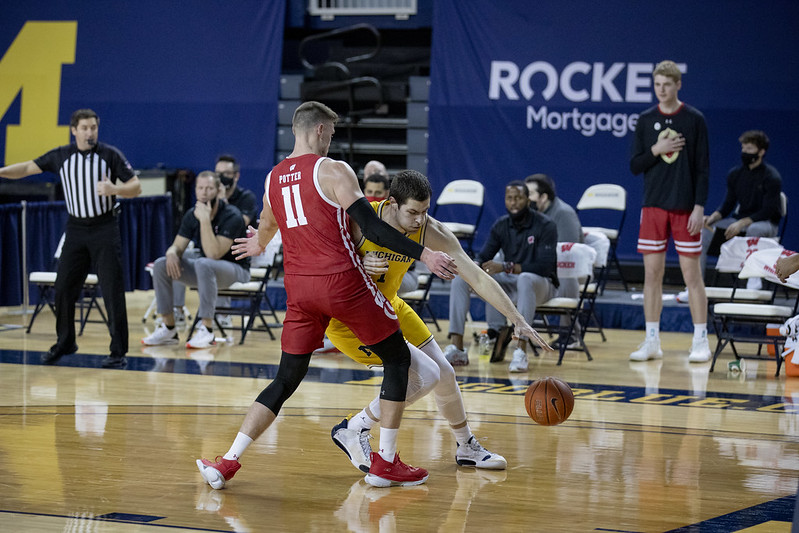
the one UW big man capable of holding this position [Campredon]
THE JAREN JACKSON JR. AWARD: MICAH POTTER, WISCONSIN
Given to the most underutilized high-level player.
This situation only got worse at the season went on. One of the biggest mysteries of the season is what the hell Micah Potter did to deserve this treatment from Greg Gard:
| ORtg | Usage | OR% | DR% | Blk% | Stl% | 2P | 3P | FT | PPG | RPG | APG | MPG | |
|---|---|---|---|---|---|---|---|---|---|---|---|---|---|
| Micah Potter | 116.8 | 28.0 | 9.6 | 20.9 | 3.9 | 1.8 | 67-107 (62.6%) | 26-73 (35.6%) | 38-44 (86.4%) | 12.5 | 5.5 | 1.3 | 22.1 |
| Nate Reuvers | 90.2 | 23.7 | 5.2 | 12.5 | 5.3 | 0.8 | 56-114 (49.1%) | 5-39 (12.8%) | 25-32 (78.1%) | 7.6 | 3.0 | 0.5 | 20.3 |
Those two big men split minutes damn near down the middle. Both averaged 3.5 fouls per 40 minutes. The only stat in which Nate Reuvers did relatively better was blocked shots and he gave all that back and more by being a non-factor on the defensive glass. I don't understand it and I never will.
Other contenders: None. Potter is in a league of his own in this category.
MOST EXTREME JUST A SHOOTER™: JUSTIN AHRENS, OHIO STATE
The player with the biggest disparity between three-point and two-point attempts.
Magnificent (via Synergy).
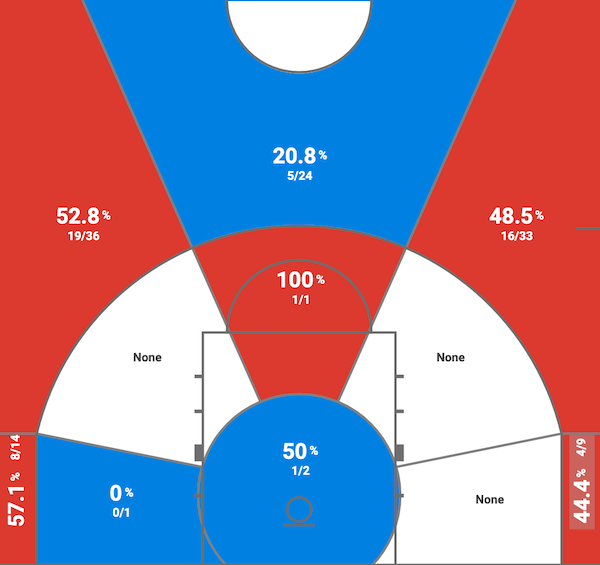
Yes, that chart is complete: Ahrens attempted four two-pointers all year. One of Ahrens' two makes was a transition pull-up with his foot on the three-point line. When he appeared inside the arc, it was either by accident or the play was so open you or I would have a legitimate chance of finishing.
Other contenders: Myles Dread, Brad Davison (for makes, not attempts)
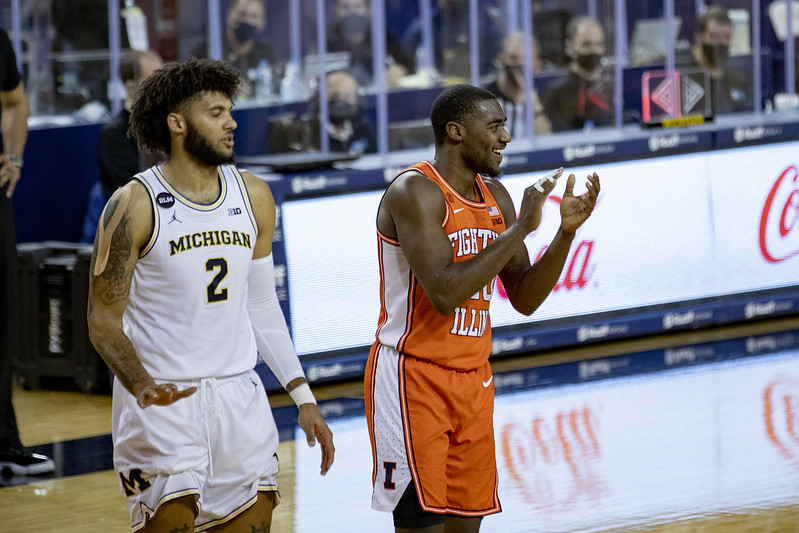
the best shot we have of Williams: waiting for someone else to shoot FTs [Campredon]
THE INVISIBLE MAN: DA'MONTE WILLIAMS, ILLINOIS
The rotation player who makes the least discernible offensive impact by both usage and effectiveness, with the former weighted more than the latter.
Da'Monte Williams is on the court for his defense. If I'd put together an all-defensive second team, he probably would've made it. He also doesn't need to be an assertive offensive player. Illinois would much prefer a possession end in a shot created by Ayo Dosunmu, Kofi Cockburn, Trent Frazier, Andre Curbelo, Adam Miller, or even Giorgi Bezhanishvili. There's one exception: when Williams and his achingly slow release is given space to shoot a three-pointer.
Williams played 26 games. He went 20/39 from three, 10-22 from two, and 20-32 on free throws—and he only got to the line that often because teams intentionally fouled him at the end of games. The vast majority of his rebounding came on defense. He stood behind the arc, waited for an opening, took a couple shots a game, and got back on defense, where the real work began.
This resulted in a 9.6% usage in Big Ten play, two percentage points lower than the mythical Thorir Thorbjarnarnson, who had the second-lowest usage among those who played at least 40% of their team's minutes.
Other contenders: Thorir Thorbjarnarson, Anthony Gaines
DISASTER FACTORY: BOTH GACH, MINNESOTA
An "award" usually given to the wildest ineffective high-usage player, though style points on both ends of the floor are taken into account. Brian likes to use statistical parameters; I prefer to lean more on feelingsball.
You may have noticed the lone name "above" Rocket Watts on the list of players with the worst O-Rating embedded earlier. Utah transfer Both Gach had seen his efficiency drop off as a sophomore while playing a point-forward role. Playing alongside Marcus Carr in a more natural off-ball/secondary playmaker role should've resulted in a step forward.
Instead, his shot was a mess—37% on twos, 19%(!!!) on threes—and he was one of the most turnover-prone players in the league. He'd toss the ball out of bounds as a cutting teammate vacated the spot, take extra steps on drives, plow into set defenders, and just plain give the ball to opponents:
He also had his defensive lapses. He posted the sixth-worst defensive BPM in the league (min. 40% minutes); though his overall defense was solid by some measures, his mistakes were noticeable, and that's what this award is all about. Gach led this category wire to wire. May the entertainment he provided give him the necessary karma for a Jacob Young-like improvement next year.
Other contenders: Chase Audige, Jamal Mashburn Jr.
March 11th, 2021 at 12:26 PM ^
Liddell reminds me of a young Charles Barkley, with better range. Baller.
March 11th, 2021 at 12:43 PM ^
Calm down Fred Jackson.
March 11th, 2021 at 12:46 PM ^
I thought so too, at first, but then I realized that Barkley had incredible explosiveness and elite leaping ability at that size. By comparison Liddell is slow.
Yeah I would say Liddell is closer to someone like Paul Millsap than Barkley.
Even Millsap was an incredible rebounder for his size early in his career. Liddell reminds me of Malik Rose or Marreese Speights - an NBA backup who can light it up but isn't well-rounded enough to be a starter.
Liddell playing next to a taller guy would help OSU defensively, but they might lose some at the other end. Part of what makes him so effective is his ability to shoot the three and draw opposing 5's away from the rim. If you put him at the 4 you lose that. OSU did that for some reason down the stretch against Illinois and it backfired.
that's why he said put him at the 4 next to a 5 that can also stretch the floor and shoot threes.
EJ Liddell is one of the players that for the good of basketball as a sport I wish was blessed with like another few inches of height. He's such an elite power forward, but just wasn't blessed with that extra few inches. Feels weird to say about an OSU player.
One of the biggest mysteries of the season is what the hell Micah Potter did to deserve this treatment from Greg Gard
It's pretty clear that there was a toxic relationship between Gard and Potter. You could see it during the games with them chirping at each other pretty regularly
I had no idea that a Thorir Thorbjarnarnson even existed.
Congrats. Avoiding Nebraska basketball is a healthy practice.
Comments